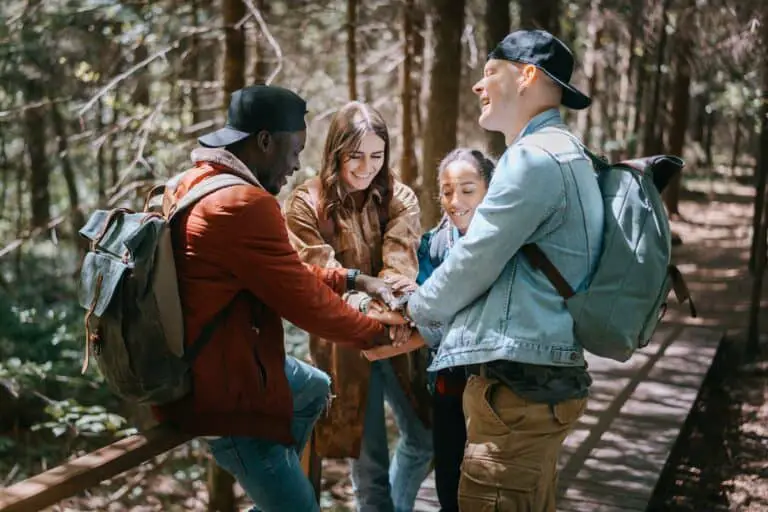If you’re like me, the thought of your first hike might feel a bit daunting. But don’t worry, I’m here to help you prepare for this exciting adventure. In this article, I’ll share some essential tips that’ll make your first hiking experience a memorable one.
We’ll cover everything from what to pack, to choosing the right trail, and even how to stay safe during your hike. So, whether you’re planning a short day trip or an overnight expedition, these tips will come in handy.
Choosing the Right Trail

It’s crucial to choose the appropriate trail for my first-time hiking experience. Picking the right trail can make or break my intro to the world of hiking. Being over-prepared is better than realizing halfway that it’s too much for my abilities.
Remember to evaluate the trail’s length and difficulty. Trails won’t just differ in miles; they’ll vary in conditions too. Some are flat, others hillier, and some might even require climbing. I’ll make sure to check the trail’s profile and gauge the ups and downs along the itinerary. At this stage, it’s better to underestimate my capabilities to ensure confidence builds over time.
Beyond this, I’ll consider the trail’s popularity. More popular trails can offer a sense of security for a beginner as encountering fellow hikers provides moments to chat, learn and, sometimes, even tag along. On the other hand, less popular trails can offer solitude and tranquility, which might be my preference.
Checking weather conditions before heading out is essential. Different trails react differently to varying weather conditions. Some can be very muddy and slippery after rains, while heat can make others exceedingly tiring. Understanding how the weather impacts a trail can be critical for my hiking experience.
Here’s a list of other factors I’d take into account when choosing the right trail:
- Accessibility: Is the trail easy to reach by car or public transit?
- Facilities: Does the trail offer shelters, restrooms, or camping places if it’s an extended hike?
- Wildlife: What flora and fauna can I expect to encounter on the trail?
Essential Items to Pack

Remember, a well-prepared hiker is a safe hiker. Now that we’ve figured out how to choose the right trail for your first hiking experience, let’s get our backpacks ready. This doesn’t mean overloading with everything I have at home. Instead, opt for items that are essential. Your aim here isn’t to pack light but right.
Top on the list should be a good quality hiking map and a compass. Even if you’re relying on your phone, always carry a physical map and compass as a backup. Meanwhile, technology isn’t foolproof and can often let you down especially in remote hiking trails.
Next, make sure to pack water and high-energy food. Keep in mind that hiking can be a strenuous activity. Physical exertion and high altitudes can lead to dehydration faster than you think. As a rule of thumb, pack at least one liter of water for every two hours of hiking time. High-energy snacks like trail mix, energy bars, and fruit are essential too.
Now let’s move on to clothes. Depending on the weather and topography of your chosen trail, layers of clothing might be necessary. Always carry a light rain jacket even if rain isn’t forecasted. Also, a hat or cap for sun protection, and a lightweight down jacket for when it becomes chilly.
Add a first-aid kit to your essentials list. It should contain bandages, antiseptic cream, insect repellent, pain relievers and personal medication. You never know when you might need it.
Let’s not forget essential gear. A robust, comfortable pair of hiking boots is perhaps the most crucial piece of equipment you can invest in. In addition to this, consider packing a headlamp with extra batteries, a multipurpose tool, a whistle for emergencies and a good sunscreen.
Lastly, if you’re planning for overnight hikes, you’ll need to consider additional equipment like a lightweight but durable tent, sleeping bag, and a cooking stove.
Next, we’ll look into some specific considerations for staying safe during the hike. Stay with me as I share some vital tips on hiking safety.
Dressing for the Hike
Packing your bag is the first step, but what about the clothes on your back? Dressing appropriately for a hiking trip is just as important, if not more. Let’s explore what you need to consider.
Firstly, it’s worth noting that layering is key. Weather in the great outdoors can be unpredictable, regardless of the season. You may start your hike in bright sunshine, but it could get chilly quickly as you gain elevation or as the day turns into night. Layering your clothing allows for easy adjustments as conditions change. Pack lightweight and moisture-wicking base layers, an insulating mid-layer for warmth, and a waterproof outer layer to protect against rain or wind.
Next up, choose the right footwear. Ill-fitting or unsuitable shoes can quickly ruin a hiking experience. Here, your choice depends on the trail. If the trail is relatively flat and easy, you might be okay with sturdy running shoes. But if it’s rocky, uneven, or muddy, you’ll need a good pair of hiking boots with solid ankle support and a grippy sole.
Let’s not forget about accessories. A sun hat and sunglasses protect you from harmful UV rays in sunny weather, while gloves and a warm hat are essential for cold conditions. Always pack a pair of dry socks, because nobody likes wet feet.
Lastly, it’s a smart idea to pack a change of clothes stored in a waterproof bag. You’ll thank yourself if you get soaked in a downpour or decide to take a spontaneous swim in a mountain lake.
Remember, comfort and practicality should be your guiding principles when dressing for a hike. Dress smart, plan for changes, and your hiking experience will be all the better for it. The upcoming sections will delve into further aspects of hiking preparation, like staying safe on the trail and leaving no trace.
Planning Your Route

An integral part of any hike, especially for beginners, is Planning Your Route. It’s not just about picking the destination but also understanding your journey’s path. For example, knowing what sort of terrains to expect, possible water sources, and the location of campsites if planning an overnight expedition.
Let’s start with mapping your route. Now that you’ve chosen your trail, it’s time to get detailed. A topographic map will be your best friend on this adventure. You can get these online or at your local sporting goods store. Learn to read the symbols and identify the contour lines; this will give you a sense of the trail’s steepness, the type of terrain you’ll encounter, and potential challenges.
In addition to mapping, look into trail conditions and restrictions. Is the trail one-direction, or can you veer off-road? Is it accessible for the entire year, or are there certain seasonal restrictions? Some areas may have rules against overnight camping or require a permit. National park or forest websites often provide this information. If not, you can always call their office to verify.
The next part of your route planning involves tackling logistics. Let’s consider the time factor. You should calculate how long the hike will take, bearing the hike’s difficulty, your fitness level, and breaks in mind. It’s also crucial to plan your start time to prevent being on the trail after dark, especially if you’re not camping overnight. Always remember, it’s better to start early to give yourself plenty of daylight hours.
It’s worth mentioning that the best way to stay safe and stick to your hike plans is to share your route with a friend or family member. Provide them with details of your trek, including your expected timeline, the trails you plan to use, and when you plan to return. It’s a great precautionary measure, particularly for solo hikers.
This all might sound tedious, but trust me, there’s nothing like being well-prepared. With your route mapped, logistics tackled, and someone aware of your plan, you’re setting yourself up for a challenging but fun-filled and rewarding hiking experience. Let’s move forward and learn about staying safe on the trail.
Safety Precautions
Getting ready for a hike involves more than packing the right gear and picking a trail. Safety stands as a paramount concern for any hiker, especially if it’s your first time stepping onto the trail. There are specific safety precautions you should consider to keep yourself secure and enjoy the experience confidently.
One critical element in ensuring your safety is to educate yourself about the animals you might encounter on the trail. Some regions may be home to potentially dangerous wildlife like snakes, bears, or mountain lions. Learning how to react if you come across these animals can make a significant difference. It’s also wise to avoid feeding or disturbing wildlife – respect these creatures in their habitat.
Your physical well-being is another aspect to safeguard. This involves keeping well-hydrated and replenishing lost energy with high-calorie foods. There also exists an unwritten rule among hikers: “Pack out what you pack in.” Hold onto your litter and dispose of it properly once you’re off the trail, not only to preserve the environment but also to prevent attracting animals with the scent of food.
Dehydration and exposure, be it to the sun, cold, or other elements, can pose severe risks. Always make sure to dress appropriately for the weather and apply sunscreen regularly. It’s also recommended to wear a hat and sunglasses and ensure you have ample water along with purifying tablets or a water filter, just in case.
It’s also smart to be aware of your surroundings and stay on the marked path. Straying from the established trail can lead to unnecessary risks, like getting lost or encountering hazardous terrain. Navigating with a compass and map might seem old school in our digital age, but these tools come in handy when you’re in the backcountry where cell signals can be unpredictable.
Lastly, don’t forget about communication and let someone know about your hiking plans. Whether it’s a park ranger or a loved one, ensure someone knows your route, expected return time, and what to do if you don’t turn up as expected.
Now that we’ve outlined these precautions, let’s move forward to another integral aspect of hiking – minimizing our impact on the environment while on the trail. We call this the “Leave No Trace” principle, which we’ll discuss in the next section.
Conclusion: First Time Hiking Tips
So, there you have it – my top tips for first-time hikers. Remember, preparation is key. Choosing the right trail and packing accordingly can make or break your hiking experience. Don’t underestimate the importance of safety measures. Your first hike doesn’t need to be a daunting task. With the right mindset and preparation, it can be an exciting adventure.
As you embark on your hiking journey, keep these tips in mind. They’re not just for your first hike but for every hike you’ll take. The beauty of hiking is that there’s always something new to learn and experience. So, go out there, explore, and most importantly, enjoy the great outdoors! Happy hiking!


